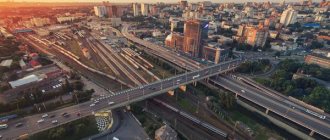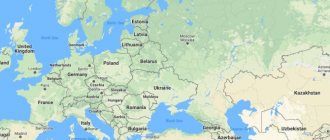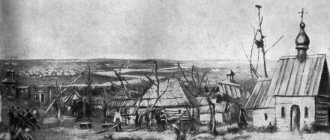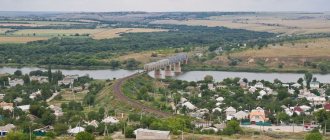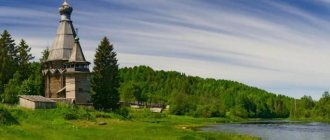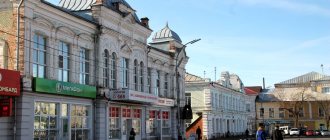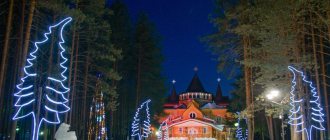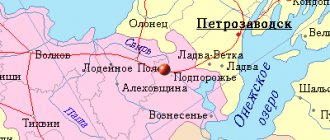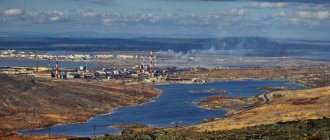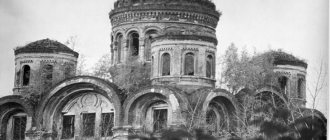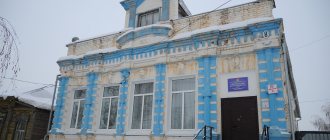This term has other meanings, see Proletarsk.
| City Proletarsk A country
| |||||||||||||||||||||||||||||||||
| Proletarsk Moscow |
| Rostov-on-Don Proletarsk |
Audio, photo and video
on Wikimedia Commons
Proletarsk
- a city in the Rostov region.
The administrative center of the Proletarsky district of the Rostov region and the Proletarsky urban settlement.
The population is 19,504[1] people. (2016).
Story
The history of the area goes back more than three centuries. Once upon a time, Grand Duke Nikolai Nikolaevich visited the Kara-Chaplak settlement and on July 3, 1875, the tsar’s highest order appeared: “Enroll the village on the Kara-Chaplak tract into the estate of the Don Cossack Army and call it Grand Ducal.” In 1915, in the village of Velikoknyazheskaya there were 974 households, 31,221 tithes of land allowance, 4,900 men and 4,400 women lived. Here were located the office of the district ataman, the office of the district military commander, the district land council, the district treasury, the district zemstvo hospital, a bacteriological station, the village administration, a veterinary hospital, 2 churches, a real school, a higher primary women's 4-grade school, 2 parish schools, craft school, factories: 2 oil mills, lime, tile, pot, brick, 3 steam and 9 windmills, fairs were held annually on January 30, Friday of Easter week, August 29 and October 1.
As a result of a new administrative division, the Proletarsky district was formed in 1924, and in 1925 the village of Velikoknyazheskaya was renamed Proletarskaya.
In 1944, part of the territory of the former Kalmyk region was annexed to the district.
In 1963, another consolidation of the district took place due to the annexation of the Oryol district, which in 1965 was separated into an independent administrative unit. In the same 1965, the region was strengthened by annexing part of the territory of the Semikarakorsky district.
In connection with the celebration of the anniversary of the village on July 24, 1970, it was renamed to the city of Proletarsk[2] (district subordination).
The ancient history of the city of Proletarsk dates back to the Greco-Sarmatian times of the Don region and the early Middle Ages of the Khazar Kaganate and Great Bulgaria. On the territory of the city, near the Cheprak estuary, there was an ancient settlement[3], representing an outpost settlement on the trade route from the Caucasus.
In 2015, residents initiated an initiative to return the historical name; letters on this matter were sent to the city authorities and the regional governor[4].
Memorable Events
- 1875 - Decree on the name of the Kara-Chaplak tract (old style) to the village of Velikoknyazheskaya.
- 1878 - The Floro-Lavra Church was built in St. Grand Ducal.
- 1897 - A free public library-reading room was created in the village. Grand Ducal.
- 1898 - The Tsaritsino-Tikhoretsk railway was built through the station. Velkoknyazheskaya.
- 1900 - The population of the village was 3114 people.
- 1911 - The Alexander Nevsky Cathedral in St. was consecrated. Grand Ducal.
- 1912 - The post and telegraph office began to operate. The zemstvo hospital emergency room has been opened.
- 1913 - District Ataman V.M. Zolotarev came on a visit.
- 1920 - Orphanage No. 1 was founded in the Grand Ducal village.
- 1921 - As a token of gratitude for sending a gift to starving Moscow, V.I. Lenin sent a letter to workers, artisans, employees and the commissar of the Proletarskaya station of the Vladikavkaz railway. In the workers' club named after Maxim Gorky, to the sounds of a brass band performing “The Internationale,” the grand opening of a party-Soviet school with a two-month course of study took place. The village became a major center of political and cultural life.
- 1925 - By decision of the Presidium of the All-Russian Central Committee, the village of Velikoknyazheskaya, Salsky district, North Caucasus Territory, was renamed Proletarskaya.
- 1935 - An order was signed by the Azov-Black Sea Regional Land Administration on the creation of a new Proletarskaya MTS (machine and tractor station).
- 1943 - The buildings of the district hospital, outpatient clinic, malaria station, cinema, and House of Culture are restored after the war. The House of Disabled People and Collective Farmers was opened.
- 1945 - Kultpolitprosvet was created.
- 1953 - The railway station building was restored.
- 1955 - A children's library was opened.
- 1956 - A boarding school was organized on the basis of the Proletarsky Pedagogical School. The number of students was 210 people[5].
- 1967 - Stanichniki celebrated the Great October holiday in the new building of the district House of Culture. In honor of the anniversary of the Motherland, the 50th Anniversary of October Avenue was created. In the same year, the People's Friendship Park was founded. On the occasion of the anniversary of the Motherland, the first music school in the region began operating
- 1968 - In connection with the anniversary: the 50th anniversary of the All-Union Communist Youth Union, one of the streets was renamed the street 50 years of the Komsomol
- 1969 - Orion cinema opened
- 1970 - The village of Proletarskaya was renamed the city of Proletarsk
- 1973 - City Vocational School No. 68 was opened [gounpopu94.dx8.ru (currently PU No. 94)]
- 1975 - The title “People's group” was awarded to the dance group of the district and the theater of the district House of Culture
- 1976 - The building of the regional hospital was put into operation for the October holidays
- 1977 - A park named after the 60th anniversary of the October Revolution was founded in the city center. A monument to the First Communards was erected on Station Square[6] (a memorial plaque with the text of a letter from V.I. Lenin and two carriages in which the Communards of the railway commune “Path of Truth” sent bread to Moscow in 1920)
- 1979 - In the year of the 60th anniversary of the First Cavalry Army, a hydropark was founded. Its uniqueness is due to its location near a non-freezing spring on the Cheprak River. In honor of the 60th anniversary of the First Cavalry Army in the city of Proletarsk, a monumental monument to the first horsemen was erected[7]
- 1985 - In honor of the 40th anniversary of the Victory, one of the city streets was renamed the street of the 81st Naval Brigade, which took part in the liberation of the city
- 1986 - Children's art school opened
- 1987 - The Sambo-90 sports club was created. In the year of the 70th anniversary of the Great October Revolution, secondary school No. 6 for 1,176 places with a gym, a canteen, and spacious classrooms was built in the city.
- 1988 - The 13th kindergarten appeared - “Forest Fairy Tale”, which is attended by 160 children
- 1990 - Immediately 140 families received the keys to new apartments. In May, the Memorial to the Fallen was opened in the city center
- 1991 - An art school was founded on the basis of music and art schools
- 1993 - The Temple of Florus and Laurus in Proletarsk was consecrated
- 1994 - In the Khundushka region, on the basis of special workshops for repairing combine harvesters, cable production was organized -
- 1995 - The Dynamo football team was created on the basis of the police department
- 1997 - ROCK Youth Sports School No. 20 was opened
- 2006 - A solemn opening ceremony of the Memorial Stone took place on the territory of the Park of Culture and Recreation at the site of the construction of the Truba Architectural and Park Complex. The project has no analogues in the entire history of world civilization. Each of its elements is filled with deep meaning. To embody this unique monumental structure, classical Roman architecture was chosen, relevant at all times, thanks to its consistency of form, beauty and grandeur.[8]
Interesting Facts
File:Cool 6.jpg 250px
Have you ever heard about the story of our Manych-Gudila? There were also stories that once people lived near Manych and one night they heard the howl and groans of the lake, the water was seething and making noise. Since then, Manych has been called “Rattling”.
There is also a mysterious story about Baer's mounds. To the northeast of Lake Manych-Gudilo there is a smooth plain. But what is it? The monotonous plain is cut through by elongated hillocks of regular shape. They stretch in parallel rows from east to west. These are the Bera mounds. They start near the city of Proletarsk and reach almost the Caspian Sea. And they were named after the traveler Karl Maksimovich Baer. He was the first to examine this mysterious phenomenon of Manych nature.
Population
| Population | ||||||
| 1897[9] | 1939[10] | 1959[10] | 1970[10] | 1979[11] | 1989[12] | 1992[10] |
| 5583 | ↗11 300 | ↘10 672 | ↗16 278 | ↗19 151 | ↗19 422 | ↗19 600 |
| 1996[10] | 1998[10] | 2000[10] | 2001[10] | 2002[13] | 2003[10] | 2005[10] |
| ↗19 900 | ↘19 800 | ↘19 600 | ↘19 500 | ↗19 572 | ↗19 600 | ↘19 400 |
| 2006[10] | 2007[10] | 2008[10] | 2009[14] | 2010[15] | 2011[10] | 2012[16] |
| →19 400 | ↘19 300 | →19 300 | ↗19 369 | ↗20 267 | ↗20 300 | ↘20 206 |
| 2013[17] | 2014[18] | 2015[19] | 2016[1] | |||
| ↘20 016 | ↘19 793 | ↘19 623 | ↘19 504 | |||
The first general census of 1897
According to the publication edited by N. A. Troinitsky “Settlements of the Russian Empire with 500 or more inhabitants, indicating the total population present in them and the number of residents of the prevailing religions, according to the first general census of 1897”:
- XII. Don Army region. Velikoknyazheskaya, village. There are 5292 Orthodox Christians. The male population is 2936, the female population is 2647, in total - 5583.
Infrastructure
Education
GBPOU RO "Proletarsky Agrarian-Technological College" (formerly PU-94)
The city has 5 secondary educational institutions (lyceum No. 1, gymnasium No. 3, schools No. 4 named after Nisanov Kh.D., No. 5 and No. 6).
Preschool education in the city of Proletarsk is represented by 5 preschool institutions (kindergartens No. 3 “Zvezdochka”, No. 5 “Beryozka”, No. 6 “Smile”, No. 15 “Golden Cockerel”, No. 32 “Forest Fairy Tale”).
Additional education: MBU DO Center for Additional Education of Children.
Medicine
On the territory of the city of Proletarsk there is a municipal healthcare facility “Central District Hospital of the Proletarsky District”. In its structure, the hospital has a hospital (with 174 beds, including 49 day stays), admission, therapeutic, surgical, pediatric, and gynecological departments. The structure of the hospital also includes a polyclinic department, the offices of which are located on the street. Chernyshevsky, 29 and Svobodnaya street, 40.
Culture and sports
- MUK Proletarsky district "Intersettlement Central Library"
- MUK "District House of Culture of the Proletarsky District"
- MBU DO "Children's Art School" of Proletarsky District
- MBUK "Museum of Local Lore of the Proletarsky District"
- Swimming pool "Neptune"
- MBU DO Youth Sports School in Proletarsk
Notable natives
- Chrysanf (Shchetkovsky) (in the world Christopher Petrovich Shchetkovsky; 1869-1906) - Bishop of Elisavetgrad, vicar of the Kherson diocese of the Russian Orthodox Church.
- Amatuni, Petronius Gai (1916-1982) - Soviet science fiction writer.
- Burnazyan, Sergei Avdeevich (1918-1943) - Hero of the Soviet Union (1944).
- Terentyev, Boris Ivanovich (1923-1981) - Hero of the Soviet Union (1943).
- Mikel, Boris Miroslavovich (1947-1999) - Soviet statesman and party leader.
- Samokhin, Alexander Nikolaevich (born 1955) - Soviet and Russian theater and film actor.
- Budyonny, Semyon Mikhailovich (1883-1973) - Soviet military leader, one of the first Marshals of the Soviet Union, three times Hero of the Soviet Union, holder of the St. George Cross of all degrees. Commander of the First Cavalry Army of the Red Army during the Civil War.
Geography
Proletarsky (rural) district is located in the south-eastern part of the Rostov region and borders on the north with Veselovsky, Semikarakorsky and Martynovsky districts; in the east - with Orlovsky; in the south - with the Salsky district and regions of the Republic of Kalmykia; in the west - with the Veselovsky and Salsky districts. The area of the district is 2720 km².
The coldest month is January with an average monthly temperature of 4.4 C, and the hottest month is July (24.1 C), with an average annual temperature of 9.9 C. The maximum amount of precipitation falls in May and June - 56 mm, and the minimum in October - 29 mm with an average annual precipitation of 511 mm. The predominant wind directions in winter are south-easterly, and in the summer months - easterly and south-easterly. The highest average wind speed is observed in February and is 5.6 m/sec, the lowest in June - 3.4 m/sec with an annual average of 4.4 m/sec.
The main water arteries are the Proletarsky reservoir, the Proletarsky irrigation canal, the Manych and Chaprak rivers.
Lands of the region
The total land use area is 272.830 thousand hectares, including arable land - 149 thousand 534 hectares. Of these, the state forest fund amounts to 4.2 thousand hectares. 15 km from the station. Budyonnovskaya is located Rodnikovskoe forestry - artificial oak plantations, which are federal property.
An excerpt characterizing Proletarsk (city)
A short, plump man of about 30, in white trousers, over the knee boots and one cambric shirt, apparently just put on, stood in this room; the valet was fastening a beautiful new silk-embroidered belt on his back, which for some reason Rostov noticed. This man was talking to someone who was in another room. “Bien faite et la beaute du diable, [Well-built and the beauty of youth," this man said, and when he saw Rostov he stopped talking and frowned. -What do you want? Request?... – Qu'est ce que c'est? [What is this?] - someone asked from another room. “Encore un petitionnaire, [Another petitioner,”] answered the man with the help. - Tell him what's next. It's coming out now, we have to go. - After the day after tomorrow. It’s too late... Rostov turned and wanted to leave, but the man in the arms stopped him. - From whom? Who are you? “From Major Denisov,” Rostov answered. - Who are you? Officer? - Lieutenant, Count Rostov. - What courage! Give it on command. And go, go... - And he began to put on the uniform handed to him by the valet. Rostov went out again into the hallway and noticed that there were already many officers and generals on the porch in full dress uniform, whom he had to pass by. Cursing his courage, frozen by the thought that at any moment he could meet the sovereign and in his presence be disgraced and sent under arrest, fully understanding the indecency of his act and repenting of it, Rostov, with downcast eyes, made his way out of the house, surrounded by a crowd of brilliant retinue , when someone's familiar voice called out to him and someone's hand stopped him. - What are you doing here, father, in a tailcoat? – his bass voice asked. This was a cavalry general who earned the special favor of the sovereign during this campaign, the former head of the division in which Rostov served. Rostov fearfully began to make excuses, but seeing the good-naturedly playful face of the general, he moved to the side and in an excited voice conveyed the whole matter to him, asking him to intercede for Denisov, known to the general. The general, after listening to Rostov, seriously shook his head. - It’s a pity, it’s a pity for the fellow; give me a letter. Rostov barely had time to hand over the letter and tell Denisov’s whole business when quick steps with spurs began to sound from the stairs and the general, moving away from him, moved towards the porch. The gentlemen of the sovereign's retinue ran down the stairs and went to the horses. Bereitor Ene, the same one who was in Austerlitz, brought the sovereign's horse, and a light creaking of steps was heard on the stairs, which Rostov now recognized. Forgetting the danger of being recognized, Rostov moved with several curious residents to the porch itself and again, after two years, he saw the same features he adored, the same face, the same look, the same gait, the same combination of greatness and meekness... And the feeling of delight and love for the sovereign was resurrected with the same strength in Rostov’s soul. The Emperor in the Preobrazhensky uniform, in white leggings and high boots, with a star that Rostov did not know (it was legion d'honneur) [star of the Legion of Honor] went out onto the porch, holding his hat under his hand and putting on a glove. He stopped, looking around and illuminating everything around him with his gaze. He said a few words to some of the generals. He also recognized the former chief of the division, Rostov, smiled at him and called him over. The entire retinue retreated, and Rostov saw how this general said something to the sovereign for quite a long time. The Emperor said a few words to him and took a step to approach the horse. Again the crowd of the retinue and the crowd of the street in which Rostov was located moved closer to the sovereign. Stopping by the horse and holding the saddle with his hand, the sovereign turned to the cavalry general and spoke loudly, obviously with the desire for everyone to hear him. “I can’t, general, and that’s why I can’t because the law is stronger than me,” said the sovereign and raised his foot in the stirrup. The general bowed his head respectfully, the sovereign sat down and galloped down the street. Rostov, beside himself with delight, ran after him with the crowd. On the square where the sovereign went, a battalion of Preobrazhensky soldiers stood face to face on the right, and a battalion of the French Guard in bearskin hats on the left. While the sovereign was approaching one flank of the battalions, which were on guard duty, another crowd of horsemen jumped up to the opposite flank and ahead of them Rostov recognized Napoleon. It couldn't be anyone else. He rode at a gallop in a small hat, with a St. Andrew's ribbon over his shoulder, in a blue uniform open over a white camisole, on an unusually thoroughbred Arabian gray horse, on a crimson, gold embroidered saddle cloth. Having approached Alexander, he raised his hat and with this movement, Rostov’s cavalry eye could not help but notice that Napoleon was sitting poorly and not firmly on his horse. The battalions shouted: Hurray and Vive l'Empereur! [Long live the Emperor!] Napoleon said something to Alexander. Both emperors dismounted from their horses and took each other's hands. There was an unpleasantly false smile on Napoleon's face. Alexander said something to him with a gentle expression. Rostov, without taking his eyes off, despite the trampling of the horses of the French gendarmes besieging the crowd, followed every move of Emperor Alexander and Bonaparte. He was struck as a surprise by the fact that Alexander behaved as an equal with Bonaparte, and that Bonaparte was completely free, as if this closeness with the sovereign was natural and familiar to him, as an equal, he treated the Russian Tsar. Alexander and Napoleon with a long tail of their retinue approached the right flank of the Preobrazhensky battalion, directly towards the crowd that stood there. The crowd suddenly found itself so close to the emperors that Rostov, who was standing in the front rows, became afraid that they would recognize him. “Sire, je vous demande la permission de donner la legion d'honneur au plus brave de vos soldats, [Sire, I ask your permission to give the Order of the Legion of Honor to the bravest of your soldiers,” said a sharp, precise voice, finishing each letter . This was said by the short Bonaparte, looking directly into Alexander’s eyes from below. Alexander listened carefully to what was said to him, and bowing his head, smiled pleasantly. “A celui qui s'est le plus vaillament conduit dans cette derieniere guerre, [To the one who showed himself bravest during the war," added Napoleon, emphasizing each syllable, with a calm and confidence outrageous for Rostov, looking around the ranks of Russians stretched out in front of there are soldiers, keeping everything on guard and motionlessly looking into the face of their emperor. – Votre majeste me permettra t elle de demander l'avis du colonel? [Your Majesty will allow me to ask the colonel’s opinion?] - said Alexander and took several hasty steps towards Prince Kozlovsky, the battalion commander. Meanwhile, Bonaparte began to remove the glove from his white, small hand and, tearing it, threw it away. The adjutant, hastily rushing forward from behind, picked her up. - Who should I give it to? – Emperor Alexander asked Kozlovsky not loudly, in Russian. - Whom do you order, Your Majesty? “The Emperor frowned with displeasure and, looking around, said: “But you have to answer him.” Kozlovsky looked back at the ranks with a decisive look and in this glance captured Rostov as well. “Isn’t it me?” thought Rostov. - Lazarev! – the colonel commanded with a frown; and the first-ranked soldier, Lazarev, smartly stepped forward. -Where are you going? Stop here! - voices whispered to Lazarev, who did not know where to go. Lazarev stopped, looked sideways at the colonel in fear, and his face trembled, as happens with soldiers called to the front. Napoleon slightly turned his head back and pulled back his small chubby hand, as if wanting to take something. The faces of his retinue, having guessed at that very second what was going on, began to fuss, whisper, passing something on to one another, and the page, the same one whom Rostov saw yesterday at Boris’s, ran forward and respectfully bent over the outstretched hand and did not make her wait either one second, he put an order on a red ribbon into it. Napoleon, without looking, clenched two fingers. The Order found itself between them. Napoleon approached Lazarev, who, rolling his eyes, stubbornly continued to look only at his sovereign, and looked back at Emperor Alexander, thereby showing that what he was doing now, he was doing for his ally. A small white hand with an order touched the button of soldier Lazarev. It was as if Napoleon knew that in order for this soldier to be happy, rewarded and distinguished from everyone else in the world forever, it was only necessary for him, Napoleon’s hand, to be worthy of touching the soldier’s chest. Napoleon just put the cross to Lazarev's chest and, letting go of his hand, turned to Alexander, as if he knew that the cross should stick to Lazarev's chest. The cross really stuck. Helpful Russian and French hands instantly picked up the cross and attached it to the uniform. Lazarev looked gloomily at the little man with white hands, who was doing something above him, and, continuing to keep him motionless on guard, again began to look straight into Alexander’s eyes, as if he was asking Alexander: whether he should still stand, or whether they would order him should I go for a walk now, or maybe do something else? But he was not ordered to do anything, and he remained in this motionless state for quite a long time. The sovereigns mounted and rode away. The Preobrazhentsy, breaking up the ranks, mixed with the French guards and sat down at the tables prepared for them. Lazarev sat in a place of honor; Russian and French officers hugged him, congratulated him and shook his hands. Crowds of officers and people came up just to look at Lazarev. The roar of Russian French conversation and laughter stood in the square around the tables. Two officers with flushed faces, cheerful and happy, walked past Rostov. - What is the treat, brother? “Everything is on silver,” said one. – Have you seen Lazarev? - Saw. “Tomorrow, they say, the Preobrazhensky people will treat them.” - No, Lazarev is so lucky! 10 francs life pension. - That's the hat, guys! - shouted the Transfiguration man, putting on the shaggy Frenchman’s hat. - It’s a miracle, how good, lovely! -Have you heard the review? - the guards officer said to the other. The third day was Napoleon, France, bravoure; [Napoleon, France, courage;] yesterday Alexandre, Russie, grandeur; [Alexander, Russia, greatness;] one day our sovereign gives feedback, and the next day Napoleon. Tomorrow the Emperor will send George to the bravest of the French guards. It's impossible! I must answer in kind. Boris and his friend Zhilinsky also came to watch the Transfiguration banquet. Returning back, Boris noticed Rostov, who was standing at the corner of the house. - Rostov! Hello; “We never saw each other,” he told him, and could not resist asking him what had happened to him: Rostov’s face was so strangely gloomy and upset. “Nothing, nothing,” answered Rostov. -Will you come in? - Yes, I’ll come in. Rostov stood at the corner for a long time, looking at the feasters from afar. A painful work was going on in his mind, which he could not complete. Terrible doubts arose in my soul. Then he remembered Denisov with his changed expression, with his humility, and the whole hospital with these torn off arms and legs, with this dirt and disease. It seemed to him so vividly that he could now smell this hospital smell of a dead body that he looked around to understand where this smell could come from. Then he remembered this smug Bonaparte with his white hand, who was now the emperor, whom Emperor Alexander loves and respects. What are the torn off arms, legs, and killed people for? Then he remembered the awarded Lazarev and Denisov, punished and unforgiven. He caught himself having such strange thoughts that he was frightened by them. The smell of the food from the Preobrazhensky people and hunger brought him out of this state: he had to eat something before leaving. He went to the hotel he had seen in the morning. At the hotel he found so many people, officers, just like him, who had arrived in civilian dress, that he had to force himself to have dinner. Two officers from the same division joined him. The conversation naturally turned to peace. The officers and comrades of Rostov, like most of the army, were dissatisfied with the peace concluded after Friedland. They said that if they had held out any longer, Napoleon would have disappeared, that he had no crackers or ammunition in his troops. Nikolai ate in silence and mostly drank. He drank one or two bottles of wine. The internal work that arose in him, not being resolved, still tormented him. He was afraid to indulge in his thoughts and could not leave them. Suddenly, at the words of one of the officers that it was offensive to look at the French, Rostov began to shout with vehemence, which was not justified in any way, and therefore greatly surprised the officers.
The Legend of Scarlet Tulips
This legend was written down in the Upper Don... When the Whites executed Podtyolkov’s Red Guard detachment and covered the grave with damp earth. And on this land the next day beautiful scarlet tulips grew. These flowers were so bright that they seemed to be burning... The ataman sent his esauls to trample down the flowers, and in the morning they looked - they had grown again. Now the tulips were brighter than before. Then the ataman ordered the horses to be led there so that they, too, would trample the flowers, but all in vain. These are our unshakable tulips. And we also call them lazoriki...
Links[edit]
Notes edit
- ^ abcdefgh Law No. 340-ZS
- ^ a b Federal State Statistics Service (2011). “All-Russian Population Census 2010. Volume 1". All-Russian Population Census 2010
. Federal State Statistics Service. - "26. The size of the permanent population of the Russian Federation by municipalities as of January 1, 2022". Federal State Statistics Service. Retrieved January 23, 2022.
- ^ abcde Law No. 183-ZS
- "On the Calculation of Time". Official Internet portal of legal information
. June 3, 2011. Retrieved January 19, 2022. - Post office. Information and computing center of OASU RPO. ( Post office
).
Search for postal service objects ( postal Search for objects
) (in Russian) - ↑
Federal State Statistics Service of Russia (May 21, 2004).
“The population of Russia, the constituent entities of the Russian Federation as part of federal districts, urban settlements, urban settlements, settlements, settlements of 3 thousand or more people.” All-Russian Population Census 2002
. - “All-Union Population Census of 1989. The current population of union and autonomous republics, autonomous regions and districts, territories, negative phenomena, urban settlements and rural district centers” [All-Union Population Census of 1989: current population of union and autonomous republics, Autonomous regions and districts , territories, regions, districts, towns and villages performing the functions of district administrative centers. All-Union Population Census of 1989
.
Institute of Demography of the National Research University: Higher School of Economics. 1989 - via Demoscope Weekly
.
Sources edit
- Legislative Assembly of the Rostov region. Law No. 340-ZS of July 25, 2005 “On the administrative-territorial structure of the Rostov region,” as amended. Law No. 270-ZS of November 27, 2014 “On Amendments to the Regional Law” On the Administrative-Territorial Structure of the Rostov Region “”. Came into force on the date of official publication. Published: “Our Time”, No. 187–190, July 28, 2005 (Legislative Assembly of the Rostov Region. Law No. 340-ZS of July 28, 2005 “ On the administrative-territorial structure of the Rostov Region”
as amended by Law No. 270 -ZS dated November 27, 2014 “
On Amendments to the Regional Law “On Administrative Management”).
-Territorial structure of the Rostov region" . Comes into force on the date of official publication.). - Legislative Assembly of the Rostov region. Law No. 183-ZS of October 22, 2004 “On establishing boundaries and conferring status on the status of the municipal formation” Proletarsky District “and the municipalities within it.” Entered into force on January 1, 2005. Published: “Our Time”, No. 266–269 (without attachments), November 3, 2004 (Legislative Assembly of the Rostov Region. Law No. 183-ZS of October 22, 2004 “ On establishing boundaries and assigning the appropriate status to the municipal formation "Proletarsky District" and its constituent municipalities (came into force
on January 1, 2005).
| vteAdministrative divisions in the Rostov region | |
| Administrative center: Rostov-on-Don • Rural area. | |
| Districts |
|
| Cities and towns |
|
| Urban settlements |
|
Interesting route around Proletarskaya station
The monument to St. Petersburg seagulls, the Kulich and Easter church, a high-rise building with a sprouted tree, the Nevskaya Zastava local history museum and a beautiful estate - we discover new interesting places around the Proletarskaya metro station.
Church "Kulich and Easter"
Upon closer examination, the composition of the ensemble turns into an architectural joke by the outstanding architect and innovator N. Lvov. The temple was built in the shape of an Easter cake, and the bell tower in the shape of Easter. In addition, this church houses a unique miraculous icon “Joy of All Who Sorrow” with pennies stuck to the paint layer during the fire.
Obukhovskoy Oborony Ave., 235
Monument "The Seagulls of St. Petersburg"
A lot of birds gather at the pier of the River Station. This is also why sculptor Yulia Muradova immortalized seagulls in stone on the granite embankment in 2013, at the same time reminding residents of the Northern capital that we live in a city by the sea, where the roll call of seagulls can be heard in the morning. Although the sculpture itself, according to the author’s idea, symbolizes “the Baltic wind, love and freedom.”
Oktyabrskaya embankment, 31, Utkina pier
The monolithic residential complex rises 24 floors above the street and looks more than monumental. It has about a thousand apartments, which are configured in the spirit of brickwork.
Obukhovskoy Oborony Ave., 195
Kurakina Dacha Park
One of the most picturesque parks on the banks of the Neva, stretching from the Volodarsky Bridge to the River Station. In the summer it is popular with runners, and in the winter it becomes a mecca of winter activities. Here, older people go skiing, and kids go downhill. It got its name from the estate of the Kurakin brothers located nearby. For a long time, the building of the Nikolaev Orphan Courses was located on the territory of the park, rebuilt in the 19th century by the architect Ioganson. Alas, a sad fate awaited this house: in 2007 it burned down. The recreated version is far from the lush original.
What to see near the Proletarskaya metro station?
And so you ended up on Proletarik, strange, I agree, very strange. Try not to leave right away - there is a lot to see.
Tree in high-rise buildings
An amazing phenomenon An amazing phenomenon for St. Petersburg built in the sixties. High-rise buildings stand out from the overall picture, but the tree especially stood out and was left.
Oktyabrskaya embankment, 64–70
Kurakina Dacha Park
The park is objectively good. The location offers a magnificent view of the Neva. In the warm season, people love sports here, especially running. In winter, snow activities are traditional. An excellent choice to visit.
Oktyabrskaya embankment, 72
"House-Megalith"
Monumental residential complex on Obukhovka. In an area far from the center, the building looks very confident.
Obukhovskoy Oborony Ave., 195
Monument "The Seagulls of St. Petersburg"
St. Petersburg is a maritime city, and seagulls are traditional companions of sailors. It was the British who shot the seagulls, but we fed them. The monument to seagulls appeared in 2013, thanks to Yulia Muradova, St. Petersburg received another symbol of the sea capital.
Estate "Dacha Chernova"
A short distance from the Volodarsky Bridge there is a building that looks more like a castle from the Middle Ages. The mansion on Oktyabrskaya Embankment surprises passersby, a building that is worth seeing.
Oktyabrskaya embankment, 72
Church "Kulich and Easter"
The amazing creation of the architect N. Lvov, the temple and bell tower fully correspond to the name. A work of art on the outskirts of the city.
Obukhovskoy Oborony Ave., 235
House of workers of Nevskaya Zastava.
The workers' building of the Obukhov plant has survived to this day only because of its historical significance. In this place the leader of the proletariat, Vladimir Ilyich, appeared. There is currently a museum here that you can visit.
Novo-Alexandrovskaya st., 23
House of ablutions and funerals
The building has passed the century mark, an architectural monument in the style of medieval Mauritania, which is rare for St. Petersburg.
Alexandrovskaya Fermy Ave., 14
